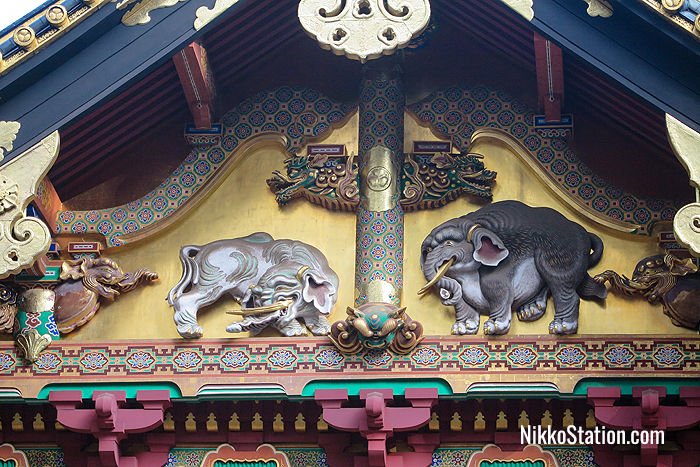Toshogu Shrine is the most famous sightseeing attraction in Nikko and is popular for its many colorful buildings which are richly decorated with gorgeous carvings. The shrine is dedicated to the spirit of the shogun Tokugawa Ieyasu (1543 – 1616), and it is also the location of his grave.
Tokugawa Ieyasu was the first of the Tokugawa shoguns who ruled Japan between 1603 and 1868, and the shrine was built the year after he died in 1617. However, most of the main buildings date from 1636 when Ieyasu’s grandson Iemitsu had the shrine enlarged. The shrine is now a large complex of ornately decorated buildings which includes five National Treasures and three Important Cultural Properties. Along with Rinnoji Temple and Futarasan Jinja Shrine it is also a registered UNESCO World Heritage Site. Here is a guide to the highlights.

The stone tori gate in front of the Nikko Toshogu Shrine
The stone torii gate in front of the shrine dates from 1618 and is a registered Important Cultural Property.

The Five-Story Pagoda
The first Five-Story Pagoda was built in 1648 but was destroyed by fire in 1815. The current pagoda dates from 1818 and is an Important Cultural Property.

The Omotemon
Omotemon means “front gate” and this is where you enter the shrine after you by your tickets. Two statues of Nio guardian spirits stand on either side of the gate. The Omotemon is also an Important Cultural Property.

The three sacred storehouses
After passing through the Omotemon you will see three sacred storehouses called Sanjinko. Under the eaves of one storehouse is a famous carving of two elephants. It is believed that the artist who created these carvings based them on written descriptions because he had never seen a real elephant. The carvings are therefore called sozo-no-zo which means “imagined elephants”.

The imagined elephants
Beyond the storehouses are the sacred stable. This was originally the home of the horse that Tokugawa Ieyasu rode in the Battle of Sekigahara in 1600.

The sacred stable
Around the stable are panels decorated with many images of monkeys. Three monkeys in particular are famous for their classic pose of “see no evil, speak no evil, and hear no evil”.

The three monkeys or “sanzaru”
Walk further and you will come to another torii gate and some stone steps which lead up to the Yomeimon.

A first view of the Yomeimon
The Yomeimon is one of the most ornately decorated gates in Japan and has 508 carvings on it. It is a designated National Treasure and is called the “higurashi-no-mon” or “twilight gate” because it is so beautiful that you could spend all day admiring the many carvings.

A closer look at the Yomeimon
Take some time to admire the carvings on the cloisters to the left and right of the Yomeimon. These galleries are beautifully decorated with clouds, birds, and other animals.

A detail of a carving on the cloisters
After passing through the Yomeimon you will see the Shinyosha, a building which is used to store the portable shrines which are carried in procession during the spring and autumn festivals.

The Shinyosha
The Karamon is a Chinese Gate which is protected by images of lions and dragons. This is another National Treasure and has a finely detailed carving of famous Chinese sages.

The Karamon

A detail of the Karamon’s carvings
The most famous carving in Toshogu is above the entrance gate that leads to Tokugawa Ieyasu’s grave. The “Nemurineko” or Sleeping Cat is said to represent the peace that Ieyasu brought to Japan after a long period of civil war.

The Nemurineko
A long series of 207 stone steps then lead up to the Inner Shrine of Toshogu.

The stone steps to the Inner Shrine of Toshogu
At the top of the steps are the buildings of the Inner Shrine which were only opened to the public in 1965. The most important structure here is the tomb of Tokugawa Ieyasu which lies beneath a 5 meter high pagoda which is made from gold, silver and copper alloy.

The tomb of Tokugawa Ieyasu
Descending back down the stone steps you will get a good view over Toshogu’s many rooftops.

The rooftops of Toshogu
A long-term renovation and repair program began at Toshogu in 2007 and is due to be completed in 2024. In the meantime there will be some scaffolding here and there around the shrine. However, as the shrine is so big and has so many buildings, this will not stop you from enjoying your visit.

Scaffolding at Toshogu
Toshogu Shrine Location Map
Toshogu Shrine is a 35 minute walk from the station area or you can take a bus which takes 10 minutes. To get there take the World Heritage Sightseeing bus from bus stop 1B outside JR Nikko Station or 2B from outside Tobu Nikko Station.
Opening Hours:
April 1st – October 31st: 8.00 – 17.00
November 1st – March 31st: 8.00 – 16.00
Admission:
Adults: 1,300 yen
Elementary & Junior High Students: 450 yen
Article and original photos by Michael Lambe. All rights reserved.
